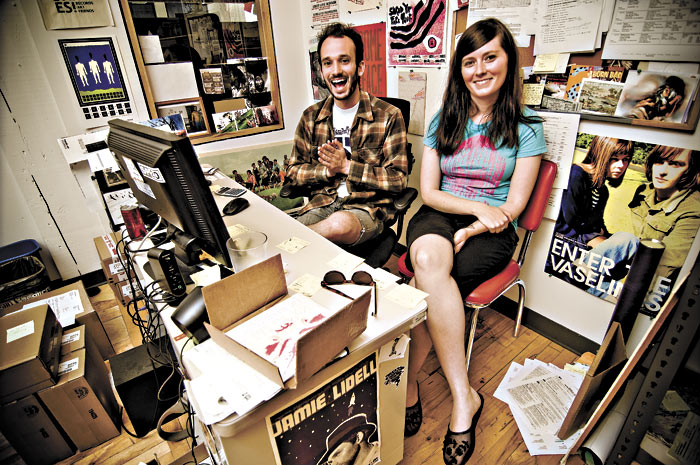It may not look like much, but since painting the walls, covering the previous obnoxious bright orange, Hardly Art’s Nick Heliotis and Sarah Moody seem pretty happy with the converted closet they use as an office. “That office used to be a storage space with no outside door,” Moody says. You can tell–it’s 10 by 25 feet, if that, and there are no windows. The tiny enclave, piled with boxes of yet-unsold albums and papered with posters of Hardly Art’s bands, functions both as office and the record label’s warehouse, in a fitting homage to its storage-closet roots. In short, it looks exactly like you’d expect the office of a small label to look.
The difference is that the door to this little hole in the wall leads to the Sub Pop office, located on the fourth story of a Belltown office building next door to Dahlia Bakery. Like the now-defunct Sub Pop offshoot label Die Young Stay Pretty, Hardly Art receives financial backing from Sub Pop, not to mention wisdom from the people who turned Sub Pop from a bankrupt, two-man DIY operation into a profitable enterprise currently employing more than 30 people. But unlike DYSP, Hardly Art is determined to live to see middle age on its own dime. It’s almost as if Sub Pop is the freewheelin’ parents and Hardly Art is the teenager living in the basement until she makes enough to move out and support herself.
Of course, when Hardly Art launched in January 2007, there was legitimate speculation whether the label would follow the short-lived (1996–99) path of Die Young Stay Pretty, which functioned more or less as a feeder label “that could try things out on a really small level to see if [a band] would eventually be a good fit for Sub Pop,” says Sub Pop general manager Megan Jasper. DYSP only signed three bands—the Black Halos, Track Star, and most famously the Murder City Devils, whose self-titled debut album came out in 1997; things fizzled after Meg Watken who had been running the label, moved to a different job.
But Sub Pop brass are keen to avoid repeating past mistakes. “As far as DYSP goes, at the time [the label began] it made sense. By the time we stopped signing bands to DYSP, we didn’t need that as an A&R component for Sub Pop,” Jasper explains.”When Hardly Art started, we were trying to make sure that Hardly Art was kept separate from Sub Pop with the exception of so many shared resources, because we didn’t want to give people the impression that it was a label where things would just be tested and where upstreaming would happen.” The ultimate hope is that bands that become successful on Hardly Art will want to stay with the label. And so far, they have.
The goal of self-sufficiency may explain in part why the folks at Hardly Art have been so successful at signing obscure, if not unknown, new bands and turning them into local scene darlings with the potential to explode nationally. And when they say new bands, they mean new. As in just-home-from-the-hospital new—like the Dutchess and the Duke, which signed to Hardly Art with only one 7″ to its name. “The Dutchess and the Duke had written two songs when we signed them, and had never played a show,” Heliotis says. “That’s how good that 7″ was.” The band went on to pack out the Wildrose, tour with Fleet Foxes, and play the 2009 Sasquatch, Pitchfork, and Bumbershoot music festivals; its sophomore release, Sunset/Sunrise (out October 6), is easily one of the most anticipated local releases of 2009.
Fellow signees like the Moondoggies have achieved a large measure of local success as well, making best-selling local-albums lists at Seattle record stores and playing sold-out gigs at the Tractor Tavern. There’s a distinct possibility that when the Moondoggies and other popular Hardly Art bands—Arthur & Yu, the Pica Beats—release follow-up albums, the label will become a nationally recognized indie powerhouse in its own right. Just like, well, Sub Pop.
Sub Pop head Jonathan Poneman could quash a group’s signing; he does, after all, still own both labels. Both the Hardly Art staff and Sub Pop employees suggest bands for consideration, but they’ve always been groups the Hardly Art crew is genuinely excited about; one of Heliotis’ favorite Seattle bands, Talbot Tagora, recently signed to Hardly Art.
While Sub Pop’s clout and financial backing plays a role, it’s Moody and Heliotis who’ve come through, in spite of—as Heliotis admits—their relative lack of experience.
At first, they both had concerns about the label’s long-term viability. Moody gave up a secure job as a publicist for Sub Pop to run Hardly Art. Heliotis started, Moody playfully jibes, as “a superfan” turned super-intern, whose enthusiasm got him his post as her “General Employee.” However, the label also offered him a front-desk position—a less glamorous job but one more or less guaranteed to stick around. At the time, the Hardly Art gig wasn’t.
But now, things are looking good for the label. While popularity doesn’t necessarily pay the bills, a handful of Hardly Art records have sold well enough to pay for themselves—all debut albums from artists unknown to much of Seattle. In an industry beleaguered by file-sharing and a recession, that’s pretty damn good. In fact, at a time when most businesses are laying off staff, Hardly Art has been able to hire a third person to help out, Dutchess and the Duke and Coconut Coolouts member Ruben Mendez (who used to work at Sonic Boom Records).
In a few more months, Hardly Art will have officially outlived Die Young Stay Pretty, which only lasted three years. “The whole reason that [DYSP] failed, from what I’ve been told, is because it was basically a starter label. So if the band was successful there, they would move on and sign to Sub Pop,” Moody explains. “But if you have a feeder label, what’s left to feed the feeder label? So Sub Pop would take all the successful bands, and Die Young Stay Pretty stayed pretty and died. I was worried that that would happen with Hardly Art, or that it was a possibility that I would be leaving this secure job that I had to try this totally unknown thing. What I didn’t realize was how determined the people at Sub Pop were to make sure that it succeeded in a way that the last venture didn’t.”






